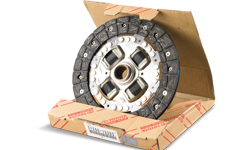Toyota Clutches
What is a Clutch?
Clutch is a mechanical device used in automotive and other machinery to engage and disengage power transmission, especially from a driving shaft to a driven shaft. Its primary function is to allow the smooth connection and disconnection of the engine to the transmission system, enabling the driver to control the power flow between the engine and the wheels. Clutches are commonly found in vehicles with manual transmissions, but they can also be present in some automatic transmissions and various industrial machines.
Function of Clutches
Clutches transfer engine power to the transmission while reducing noise and vibration. Due to the constant transaxle friction, a clutch will gradually deteriorate.
- Engaging and Disengaging Power Transmission:
- The main function of a clutch is to connect and disconnect the engine from the transmission. When the clutch is engaged (pedal released), power from the engine is transmitted to the transmission, enabling the vehicle to move. When the clutch is disengaged (pedal depressed), power flow is interrupted, allowing the vehicle to stop or change gears.
4. Vehicle Start-Up:
- The clutch allows the engine to start without causing the vehicle to move. When the clutch pedal is depressed, power transmission is disengaged, allowing the engine to run without affecting the movement of the vehicle.
7. Protection Against Overloading:
- Clutches provide a safeguard against overloading the engine and drivetrain by allowing the driver to disengage power transmission in situations where excessive load or stress on the drivetrain is encountered.
2. Smooth Gear Changes:
- Clutches enable smooth and seamless gear changes by temporarily disconnecting the engine from the transmission during shifts. This allows the driver to select a different gear without causing damage to the transmission or other drivetrain components.
5. Stopping and Idling:
- When the vehicle is at a complete stop, the clutch is disengaged to prevent the transmission from sending power to the wheels. This allows the engine to continue running while the vehicle is stationary.
8. Extended Engine Life:
- Proper use of the clutch, especially during gear changes, can contribute to the longevity of the engine and transmission by preventing excessive wear and damage.
3. Neutral State:
- With the clutch disengaged, the vehicle is in a neutral state, allowing the engine to run without transmitting power to the wheels. This is essential when the vehicle is stationary or idling.
6. Managing Engine Load:
- The clutch allows the driver to manage the load on the engine by engaging or disengaging power transmission. This is particularly important when navigating challenging terrain or driving in traffic.
9. Variable Speeds:
- The clutch allows for variable speeds by enabling the driver to shift between different gears, adapting to changing driving conditions and terrain.
Fake/Counterfeit Product
- Unreliable and poor durability
- May be made with environment damaging asbestos
- No anti skim-shim, thus more likely to squeak
- Low quality may cause brake failure
When is it time to change my Clutches?
- Slow acceleration
- Vibration
- Noise
- Difficulty in gear engagemen

Genuine Toyota Clutches
- More durable and environment friendly non-asbestos glass fibre
- Toyota Genuine Dampers absorb vibration and ensure smooth power flow and responsive acceleration
- Clutch facing has grooves for smooth run


